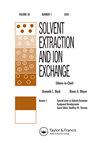Mutual Separation of Ln and an Using TODGA and DTBA with High Organic Acid Concentrations
IF 2.1
4区 化学
Q3 CHEMISTRY, MULTIDISCIPLINARY
引用次数: 2
Abstract
ABSTRACT Developing the conventional separation method by which minor actinides (MA) such as Am and Cm are separated from lanthanides is important with respect to their recovery and isolation from high-level radioactive waste (HLW). Owing to the chemical behavior of trivalent lanthanide and actinide ions with similar ionic radii, realizing this separation is still challenging. All lanthanides, Am, and Cm can be extracted using diglycolamide (DGA) extractants, and relatively high An/Ln separation efficiencies have been obtained using diethylenetriamine-N,N’,N”-triacetic acid-N,N”-bis(diethylacetamide) (DTBA). Referring to our previous study, where a good separation and a MA recovery of approximately 95% with the co-existence of 5% Nd in the aqueous phase were observed. To improve these results as well as the separation conditions, under modified conditions by adding lactic acid to stabilize pH, the recovery rates observed were as follows: 97.1% for average Ln metals with the co-existence of 1.59% Am in the organic phase and 98.4% for Am with the co-existence of 2.95% Ln in the aqueous phase.用TODGA和DTBA在高有机酸浓度下相互分离Ln和an
开发从镧系元素中分离微量锕系元素(MA)如Am和Cm的常规分离方法对于高放废物(HLW)的回收和分离具有重要意义。由于具有相似离子半径的三价镧系离子和锕系离子的化学行为,实现这种分离仍然具有挑战性。二甘醇酰胺(DGA)萃取剂可萃取所有镧系元素、Am和Cm,二乙基三胺-N,N ',N ' -三乙酸-N,N ' -双(二乙基乙酰胺)(DTBA)萃取剂可获得较高的An/Ln分离效率。参考我们之前的研究,在水相中观察到良好的分离和约95%的MA回收率,并同时存在5%的Nd。为了改善上述结果和分离条件,在加入乳酸稳定pH的条件下,观察到的回收率为:有机相中含有1.59% Am的平均Ln金属回收率为97.1%,水相中含有2.95% Ln的Am金属回收率为98.4%。
本文章由计算机程序翻译,如有差异,请以英文原文为准。
求助全文
约1分钟内获得全文
求助全文
来源期刊
CiteScore
4.40
自引率
5.00%
发文量
15
审稿时长
8.4 months
期刊介绍:
Solvent Extraction and Ion Exchange is an international journal that publishes original research papers, reviews, and notes that address all aspects of solvent extraction, ion exchange, and closely related methods involving, for example, liquid membranes, extraction chromatography, supercritical fluids, ionic liquids, microfluidics, and adsorption. We welcome submissions that look at: The underlying principles in solvent extraction and ion exchange; Solvent extraction and ion exchange process development; New materials or reagents, their syntheses and properties; Computational methods of molecular design and simulation; Advances in equipment, fluid dynamics, and engineering; Interfacial phenomena, kinetics, and coalescence; Spectroscopic and diffraction analysis of structure and dynamics; Host-guest chemistry, ion receptors, and molecular recognition.

 求助内容:
求助内容: 应助结果提醒方式:
应助结果提醒方式:


